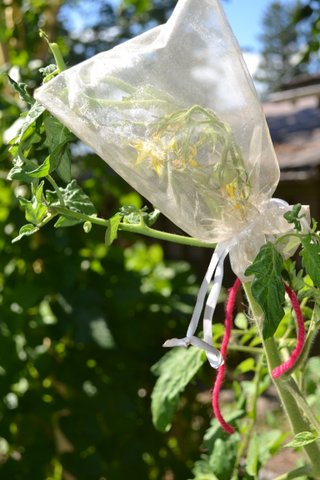Back to September 2015 Newsletter
Bag Your Tomato Blossoms

Patricia Huet
Home gardeners love growing open-pollinated tomatoes, especially heirlooms. Many of us become obsessed with trying new varieties every year, hoping to find the ultimate treasure: a gorgeous fruit with a taste to die for. We diligently save seeds from the best ones each year. But then one year you find that the near-perfect paste Opalka isn’t quite right – it’s lumpy and flavourless. A cross has happened.
Tomatoes don’t cross-pollinate easily because they usually self-pollinate before the flowers open. However, if a bee arrives loaded with pollen from another variety, a cross or hybrid may occur. You won’t know that the flowers were cross-pollinated until the following year, when you plant the seeds you saved from the resulting fruit.
If you are only saving seeds for your own use, a hybrid could be fun and interesting. But if you donate to community seed banks, sell your seeds, or even trade them at a Seedy Saturday event, a hybrid is a no-no.
There are several ways to protect tomatoes from cross-pollination, but for home gardeners with limited space and a desire to grow many varieties, there is only one practical method. You have to prevent pollinators from landing on one or more flower clusters that will eventually make fruit for seed saving. The easiest way to do this is to put a thin fabric covering over the flower clusters. This is called “bagging”.
You can make your own bags from purchased fabric like tulle or organza. You can also use floating row cover for bags, but the flower clusters may get too hot in them on warm days, which could inhibit fertilization. After a few trials and errors with making my own bags, I looked online and found that people have used “wedding favour bags” made out of white organza with a drawstring at the top. The best size for the money (in bulk, about $0.30 each) seems to be 5” wide by 8” deep. This size is also easy to get on and off the plants, and there is no need to tie the drawstrings.
The bags must be put onto a flower truss with unopened buds. You can, however, just take off any open flowers before putting the bag on. Close the bag with the drawstrings, not so tight that the stem will be strangled, but close enough to prevent the entry of insects. Mark the flower stem with bright coloured yarn. If you put the bag onto a flower cluster attached to a terminal bud, you will find that after a week, the bag is packed with leaves. Just take the bag off and reposition it on the flower cluster.
The most important thing to do to make sure that the fruit forms in the bag is to shake it daily. Not just a little tap – you need to simulate the action of a bumblebee. Some varieties form fruit easily in the bag, while others are very stubborn. If you don’t get fruit the first time, put more bags on that variety.
As soon as you see fruit in the bag and all the remaining flowers have withered, take the bag off. Leave the yarn marker in place so you know which fruit to save seed from! Sometimes fruit from bagged flowers are smaller than others on the plant, and they have very few seeds. This indicates incomplete fertilization. The cure for this is to be a better “shaker”!
Bagging is not difficult at all, although not really suitable if you are saving seeds from many plants or need a lot of seeds. But it is like being a first-time parent when you see the first fruit forming in your bags. That’s when you know that your beloved Opalka will continue to produce perfect fruit year after year.
**
Patricia Huet is the manager of the Dan McMurray Community Seed Bank at the College of the Rockies in Creston, British Columbia.
Not yet a member?
An annual membership to Seeds of Diversity gives you access to our seed exchange, seed grow-out programs, and our online news.

We depend on donations to do our work.

Thank you for your support!
